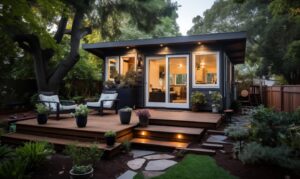Did you know that millennials make up the largest percentage of current homebuyers? According to Finance of America Mortgage and recent data from the National Association of Realtors, “Millennials — people born between 1981 and 1996 — are among the largest group of homebuyers today, making up 37% of the overall share in 2021.” With numbers like that it’s easy to see why understanding millennial home buying trends has become exceedingly important and a factor that eager home sellers should consider. But what exactly are those specific millennial home buying trends?
Finance of America Mortgage broke down the millennial home buying trends into 4 specific designations,
- Millennials are interested in newer homes with smart home technology features:
- Finance of America Mortgage says, “Sixty percent of homebuyers prefer to buy a newly built home over existing ones, according to a report from the National Association of Home Builders (NAHB). New homes come with the convenience of being move-in ready; homebuyers can expect a modern, updated home that’s aesthetically attractive. Plus, with a new home, there’s less worry over fixing plumbing issues or older appliances.”
- As far as smart home features, upgrades like Google Assistant controlling your lighting and TV’s can really go a long way. FAM noted, “A projected 30 million households are planning to add some form of smart–home technology. The term “smart home” refers to devices with controls that typically automate, control, or monitor various home functions. For instance, homeowners can install HVAC systems in which the temperature can be controlled through a connected smartphone app. Smart lighting solutions are also a popular choice; home systems like Alexa and Google Assistant can work with smart bulbs, and your voice can turn lights on and off.”
- Sustainable homes are increasingly popular with millennials:
- From saving on your electric bill to conserving energy overall, millennials have a vested interest in the sustainability of their home.
- FAM writes, “The same NAHB report states that although just 15% of homebuyers are willing to pay more for a home that’s touted as eco-friendly, 57% are willing to pay more for a home if they think they’ll save big on annual utility costs.” ENERGY STAR features are among the most desirable since a majority of homebuyers know about this green certification program. Some of these include energy-efficient appliances, windows, and lighting. Entire homes can also earn an ENERGY STAR rating; certified homes, on average, use 20% less energy than non-ENERGY STAR homes.”
- Millennial home buyers are looking for homes with space:
- With the rise of work from home jobs, millennial home buying trends are leaning towards homes with additional space to include a home office, home gym, etc.
- FAM explains, “The closure of many workspaces during the COVID-19 pandemic meant that around 75% of employees work from home full-time or do so through a hybrid model (part of the time in-person at work, the other part at home). According to a survey conducted by Pew Research Center, more than half or those surveyed (64%) would prefer working from home, even after the pandemic is over. This shifting attitude towards work could mean that millennials prefer homes with larger spaces — remote workers need somewhere to do their job, so it makes sense to have a dedicated home office. Those staying at home more often may want more space for hobbies or relaxation, such as a home gym or an outdoor lounge area. Considering that the most common type of homes purchased are detached, single-family homes, it’s safe to assume that homebuyers are looking for more space to accommodate their lifestyles.”
- Do you have a mother-in-law suite in your home? This may be a huge selling point for millennials.
- Millennials prefer the suburbs over large cities to raise families:
- From providing better school zones and space for growing families, to better “walkability” in their neighborhoods, millennials are opting for the ‘burbs when it comes to home purchases.
- FAM writes, “The 2021 NAR Home Buyer and Seller Generational Trends report shows over half of millennial homebuyers purchased homes in a suburban area. More specifically, 52% of those aged 22 to 30 and 54% of those aged 31 to 40 bought homes in suburban areas. Furthermore, U.S. Census data backs this up, with home buying trends veering towards living in suburban areas close to urban centers. The appeal of the ‘burbs is you’re more likely to find larger homes than in urban areas. Suburban areas typically have plenty of amenities, such as parks, retail, dining, and community centers. And some suburbs, particularly those close to city center, may have a faster commute time to work, better walkability, and access to transportation.”
Boiled down, understanding millennial home buying trends is quickly becoming an important aspect of home sales in 2021. Interested in learning how your home would fare in the current market? Call or chat with us now so we can connect you with your IDEAL AGENT®!






